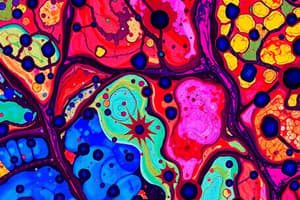Podcast
Questions and Answers
What is the primary focus of histology?
What is the primary focus of histology?
- The culture and growth of various tissue types
- The study of genetic information within cells
- The microscopic structure of cells, tissues, and organs (correct)
- The study of macroscopic structures of organisms
Which of the following is NOT a subdivision of histology?
Which of the following is NOT a subdivision of histology?
- Histo-chemistry
- Neuro-chemistry
- Cytology
- Microbial genetics (correct)
Cytogenetics primarily involves the study of what aspect of cells?
Cytogenetics primarily involves the study of what aspect of cells?
- The functions of different organ systems
- The formation and maintenance of tissue cultures
- The chemical composition of tissues
- The genetic material and its structure (correct)
Which subdivision of histology focuses on the visualization of tissue components using various staining methods?
Which subdivision of histology focuses on the visualization of tissue components using various staining methods?
What is tissue culture primarily concerned with?
What is tissue culture primarily concerned with?
What is the primary importance of understanding microscopes in histology?
What is the primary importance of understanding microscopes in histology?
Which of the following best describes a limitation of using certain types of microscopes in histology?
Which of the following best describes a limitation of using certain types of microscopes in histology?
What fundamental principle is essential for preparing tissues in histology?
What fundamental principle is essential for preparing tissues in histology?
Which method of tissue preparation is not considered a basic principle in histology?
Which method of tissue preparation is not considered a basic principle in histology?
What should a histology student prioritize when learning about microscopy techniques?
What should a histology student prioritize when learning about microscopy techniques?
What is the primary use of a Transmission Electron Microscope?
What is the primary use of a Transmission Electron Microscope?
What distinguishes a Scanning Electron Microscope from a Transmission Electron Microscope?
What distinguishes a Scanning Electron Microscope from a Transmission Electron Microscope?
Which of the following is a limitation of electron microscopy techniques?
Which of the following is a limitation of electron microscopy techniques?
In which application would a Scanning Electron Microscope be particularly useful?
In which application would a Scanning Electron Microscope be particularly useful?
What fundamental principle do both types of electron microscopes rely on?
What fundamental principle do both types of electron microscopes rely on?
Flashcards
Histology
Histology
The study of the microscopic structure of cells, tissues, and organs.
Cytology
Cytology
The study of cells, their structure, function, and formation.
Cytogenetics
Cytogenetics
The study of the genetic makeup of cells, including chromosomes and genes.
Tissue Microscopy
Tissue Microscopy
Signup and view all the flashcards
Histochemistry
Histochemistry
Signup and view all the flashcards
Microscopes in Histology
Microscopes in Histology
Signup and view all the flashcards
Tissue Preparation
Tissue Preparation
Signup and view all the flashcards
Methods of Tissue Preparation
Methods of Tissue Preparation
Signup and view all the flashcards
Understanding Techniques
Understanding Techniques
Signup and view all the flashcards
Transmission Electron Microscope
Transmission Electron Microscope
Signup and view all the flashcards
Scanning Electron Microscope
Scanning Electron Microscope
Signup and view all the flashcards
Resolution
Resolution
Signup and view all the flashcards
Study Notes
Introduction
- Presented by Dr. Nawal Sirelkhatem Omer, Associated Professor at the University of Bahri.
- The presentation is about histology.
Histology
- Histology is the study of the microscopic structure of cells, tissues, and organs.
- It is subdivided into:
- Cytology
- Cytogenetic
- Tissue microscopy
- Tissue culture
- Histo-chemistry
- Neuro-chemistry
Importance of Histology Studies
- Students should understand the applications and limitations of different types of microscopes.
- An understanding of the preparation methods for tissues is crucial.
Types of Microscopes
- Light Microscope:
- Uses light (daylight, sun, or electric).
- Consists of eyepiece lenses, objective lenses, and a condenser lens.
- Magnifications include low power (X10), high power (X40), and oil immersion (X100).
- Resolving power is approximately 0.2 microns.
- Electron Microscope (EM):
- Uses a beam of electrons.
- Resolving power is 0.002 microns.
- Magnification up to 500,000 times.
- Types include Transmission Electron Microscope (TEM) and Scanning Electron Microscope (SEM).
- Ultraviolet Microscope:
- Uses ultraviolet rays as source of light.
- Magnification is double compared to a light microscope.
- Fluorescent Microscope:
- Uses short-wavelength (ultraviolet) light as a source.
- Fluorescent substances in tissues emit visible light.
- Used in histochemistry to study chemical components.
- Phase-Contrast Microscope:
- Used to study fresh tissues or living cells in culture medium.
- Detects phase differences in light passing through the specimen.
- These differences are converted into variations in light intensity to create a visible image.
Measurement Units
- 1 centimeter (cm) = 10 millimeters (mm)
- 1 millimeter (mm) = 1000 micrometers (µm)
- 1 micrometer (µm) = 10,000 angstroms (Å)
Microscope Components (Diagram)
- Parts of a light microscope are labeled (eyepiece, objective lenses, mechanical stage, iris diaphragm, illuminator, coarse focus, fine focus, variable intensity control, arm, stage controls).
Studying That Suits You
Use AI to generate personalized quizzes and flashcards to suit your learning preferences.
Related Documents
Description
Explore the fundamental concepts of histology, including the study of cells, tissues, and organs at a microscopic level. This quiz also covers different types of microscopes and their applications in histological studies, highlighting their importance in scientific research and education.




